
Port travels to Devon on an InterCity train for an audience with its designer Kenneth Grange, the man responsible for dragging design into the mainstream – and for saving us from British ‘fudge’ in the process
Words Will Wiles
Photography Andy SewellKenneth Grange is wearing an excellent pair of overalls. Crimson, bristling with tools – a man could get some serious work done in overalls like these, and they are well suited to a lifelong designer and maker. They’re made by Engelbert Strauss, a German company, and Grange was compelled to make a change from the American dungarees he’d been dissatisfied with for years when he saw Strauss’ on Danish crime drama The Killing. “The father of the little girl wears these. Engelbert Strauss – terrific catalogue, every man should have one.”

- It was the BBC’s Wallander that first whetted Grange’s appetite for Nordic noir, and for characteristic reasons. “It was the first time I can remember seeing modernist living week-on-week,” Grange says. “Be it the police station or the prison or the school or the swimming pool, they were all modern, and it cheered me up no end. Anything else – EastEnders or Coronation Street or whatever – they’re all set in British fudge, brown and cream and tassels and all that.”
Grange’s career has been one long effort to rid Britain of its fudge and tassels. He’s one of the country’s foremost modernist designers, responsible for shaping scores of the modest but all-important objects that surround us, from London’s taxis and parking meters, to petrol stations, bus shelters, and a generation’s-worth of domestic appliances. He was also among the founding partners of the immensely successful design agency, Pentagram. But he is perhaps most famous for the distinctive styling of the InterCity 125 train, which went into service in 1976 and is still the pride of the UK’s long-distance rail network. It’s the 125 that brought us here, in more ways than one.
Top right: The parking meter in Grange’s archive is a replica produced for the 2011 Design Museum retrospective.
Right: Anglepoise has been a recurring client for Grange, and he is still designing for them today.When Grange started his career shortly after the Second World War, “The word design barely existed in the lexicon.” But the timing was fortuitous: he was to become part of the heroic generation of designers that changed design’s status for good. The 1951 Festival of Britain fused postwar recovery, national pride and modern design in the minds of the public. The firm Grange worked for at the time designed its Sports Pavilion. At the same time, the country was being rebuilt and British companies needed to update outmoded product lines. Grange remembers it as a uniquely open time, rife with opportunity, compared with the specialised, professional world of today. “If you were making irons or toasters or something, you were still using exactly the patterns you were using in 1938-39,” he says. “ a lot of industry just went straight to their drawing office… but occasionally somebody would go to the golf club or call up somebody who knew an architect or knew how to make things. That was how easy it was to get jobs that you wouldn’t get near to today. Hence the ease with which I went from a flatiron to a train.”
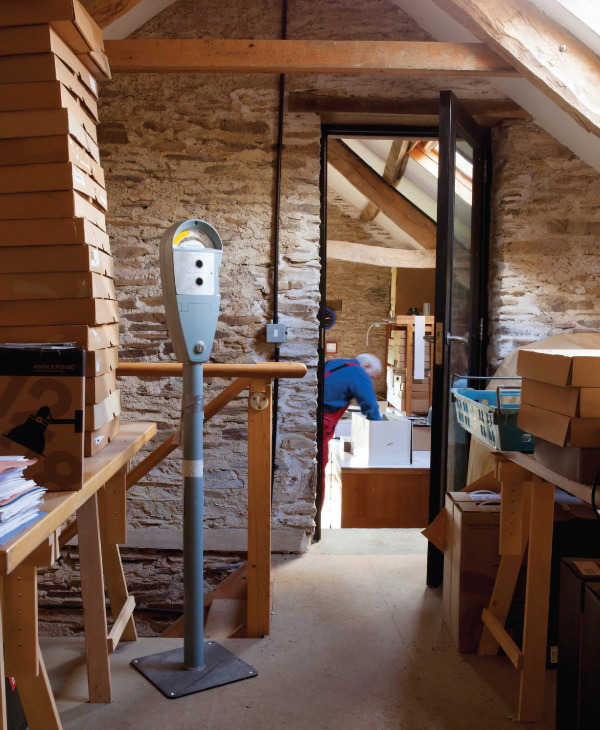
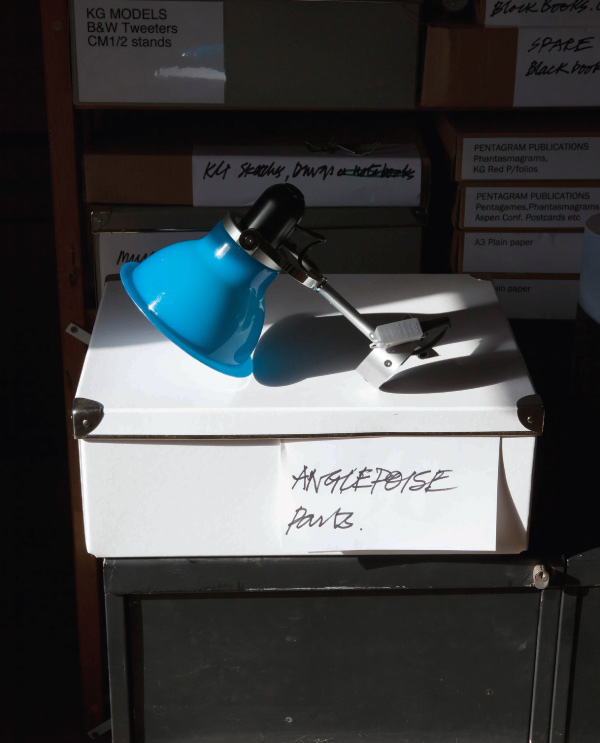

- Now 83, Grange is still designing; the excellent overalls go with an equally excellent workshop in the grounds of his home in deepest Devon, not far from Dartmoor. He tried to retire, but didn’t take to it. The neatly organised archive adjoining the workshop reveals the incredible range of household names Grange designed for from the late 1950s through to today: cameras for Kodak (including the Instamatic), razors for Wilkinson Sword, lamps for Anglepoise, and several kitchens’ worth of appliances for Kenwood. A parking meter lurks under a plastic shroud next to one of Grange’s proposed but unused seats for the InterCity – their webbing deemed too tempting a target for vandals. It was in the 1970s that Grange made the leap from irons to trains. At the time, British Rail was attempting to modernise. But its proposed next-generation high-speed train, the APT, was plagued by delays, so BR’s chief engineer worked to produce an alternate high-speed train design using the best of existing, off-the-peg technologies and equipment. Grange had done a few small jobs for BR, and the organisation’s design director, Jim Cousins, gave him the job of designing the livery for the rather ungainly locomotive that had been developed – a paint job, nothing more.
Top: The workshop contains a comprehensive collection of tools for creating models and prototypes. Right: Concept drawings from the archive.
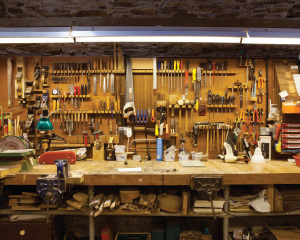


Multiple unit liveries
HST Diesel electric power car
Class 253.
Sheet no. 4/19
issued Aug 1977
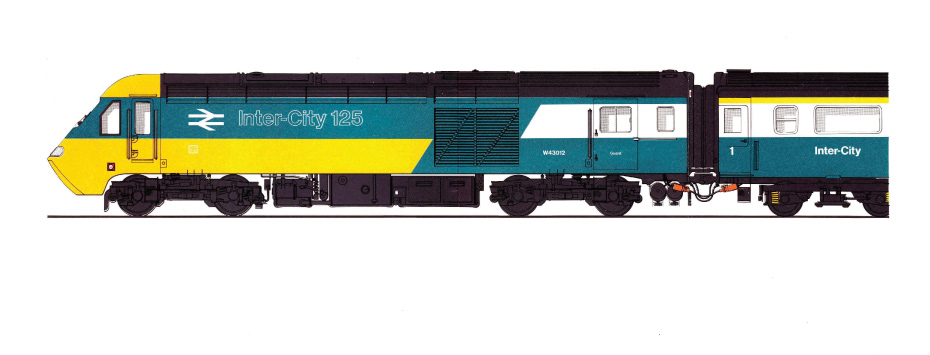
Diesel electric power car 1 680 kW BR Bo-Bo
Length 19 789mm overall, 10 300 mm bogie centres
Width 2 740mm over body, 2 810mm maximum width
Height 3 906mm maximum
Weight 70.10 tonnes (working order)
Engine Ruston-Paxman 12R200L 12 cylinder-4-stroke
Maximum continuous rated output 1680 kW
Main alternator Brush BL91-31
Traction motors, four, fully suspended, single reduction gear drive
Maximum tractive effort 80 000N at 11.6 per cent adhesion at 1490A traction currentContinuous tractive effort 45 950N at 103.3km/h at 1000A traction current
Power at rail (continuous rating) 1320 kW
Full engine output available between 56 and 200 km/h
Automatic air braking for power car and for train,
brake force as percentage of (working order)
car weight 0—145 km/h 50 per cent,
145—200 km/h 34 per cent
Minimum radius curve:
Horizontal without widening 80m
Horizontal with 20mm gauge widening 65m
Vertical convex 200m
Vertical concave 200mMaximum permitted service speed 200 km/h
Train heating equipment Brush BL 91-20
electric alternator driven by engine,
280 kW continuous output at 900V
Fuel tank capacity 4682 litres
Painting:
Rail Blue BS 381C No.114
Rail Grey BS 381C No. 627
Yellow BS 381 C No. 356
Roof, undergear and bogies Black
Symbol and outline lettering Silver
Service systems to Code DBS 5496
- “But,” Grange says, “I had quite a few weeks until it was due for delivery, and just for my own amusement tried larking about with what shape it might be. I had the good fortune to employ an engineer in the office who had worked for the aircraft industry, and he said that if it was a plane you’d go straight to the wind tunnel – that was where you’d decide what the form could be.” Every day Grange’s team made models and tested them in the wind tunnel at Imperial College, refining and smoothing BR’s unlovely prototype. Their efforts to improve the train’s aerodynamic performance were, however, limited by two factors: the ugly buffers that protruded from the front of the train, and the double-width windscreen made necessary by the union’s insistence on a two-person crew. “We had wrangled backwards and forwards over these bloody buffers to try and make them aerodynamic, and I said, ‘Take me right back to what the buffers do, I’d just like to get it in my mind clearly.’ And I remember [BR’s engineer] saying, ‘Well, in absolute truth, this train won’t need buffers.’” The HST would never need shunting; the buffers were just a hangover from older designs. Grange removed them and the result is the handsome InterCity 125 we know today, with its sloping flat front, crisp leading edge, and smooth curves. The wider two-man window ends up aiding the look, giving the train a better “graphic”, or front view. Cousins, “to his everlasting credit”, adopted the design. The APT, which was meant to take over from the 125 after a few short years, was eventually scrapped.

- Back in the archive, there are one or two important pieces missing. There’s no Adshel bus shelter, for instance – Grange was offered one but had nowhere to put it. He would, however, like to get his hands on one of the TX1 London taxis he designed, which hit the streets in 1997 and are now steadily coming out of service. That’s the problem with these commonplace objects: they can disappear without a thought being given to preservation. The meter in the archive turns out to be a replica. “They probably made nearly 100,000 of these,” he reckons. But when the Design Museum’s 2011 Grange retrospective was being assembled, they could only find three.“One in Australia, one in Birmingham, and one in a film prop supplier’s. Astonishing.” The near-ubiquity of Grange-designed objects might, paradoxically, be the reason his name is not better known today: like the parking meters and the bus shelter, his products have been vital but humble, courteous, unobtrusive, indeed almost invisible. But his influence is everywhere. You can thank him and Pentagram the next time you fill your car in the rain: their redesign of the BP petrol station forecourt was the first to add a roof. “That’s one of the least-known pieces of design history,” Grange says, “but in terms of impact on the traveller, it’s quite bloody profound.”
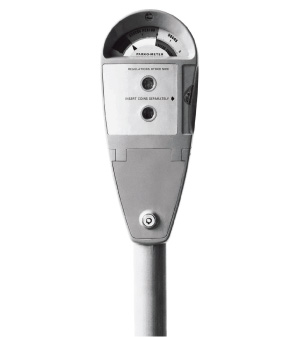
Subscribe to Port Magazine annually and receive each issue to your door.
Get PORT in print



